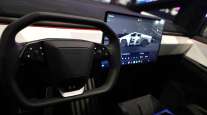Senior Reporter
NHTSA Seeks OK to Extend Data Collection for Safety Tech Study

[Stay on top of transportation news: Get TTNews in your inbox.]
The National Highway Traffic Safety Administration plans to continue gathering data for its crash-avoidance field study that is seeking comments from commercial motor carrier drivers about their beliefs and attitudes toward safety technologies.
In a May 9 announcement, the agency said it must first seek approval from the White House Office of Management and Budget to extend the driver survey and comment period on heavy-vehicle crash avoidance systems, delayed in part by the COVID epidemic.
“NHTSA is gathering information regarding drivers’ naturalistic driving experiences and opinions about crash avoidance systems consisting of lane departure warning, forward collision warning, impact alert and automatic emergency braking for heavy vehicles,” the agency said.

The extension of an original Aug. 31 deadline is necessary to continue the data collection underway to completion, NHTSA said. The data collection effort, which began in August, was delayed by not only COVID challenges but also a shortage of chips needed for use in the data acquisition system for the naturalistic driving portion of the study.
NHTSA said that as of Dec. 31, only one respondent has completed the study, three are in the field study portion and one has completed the informed consent document and pre-field study surveys.
“Crash-avoidance safety technology has been advancing rapidly since the conclusion of the previous studies, with products for heavy commercial vehicles becoming commercially available,” the announcement said. “These systems present opportunities for improving driver awareness and behavior, improving drivers’ responses to potential collisions and mitigating or preventing collisions when drivers do not respond.”

Host Michael Freeze discusses insurance coverage and costs with Jane Jazrawy of Carriers Edge and David Berno of Hub International. Tune in above or by going to RoadSigns.TTNews.com.
NHTSA said the newest generation of crash-avoidance safety technology includes several new features, such as multiple sensors, improvements to radar algorithms and new features such as full braking in response to static objects or pedestrians.
“However, it is unknown if this newest generation of products has been able to reduce the prevalence of false or nuisance alerts observed in a previous study, if there are any issues with new types of alerts that have been added since previous studies or whether drivers have negative perceptions of the technology due to these issues,” NHTSA said. “As these technologies become more popular with fleets, it is important to understand their real-world performance and any unintended consequences that may arise from them.”
The collection of information consists of an informed consent for participation, a demographic questionnaire, an initial crash-avoidance safety technology questionnaire and a post-study CAS technology questionnaire, the agency said.
Want more news? Listen to today's daily briefing above or go here for more info
The post-study survey will gauge how drivers’ attitudes and preferences may have changed over the course of participation.
NHTSA said it hopes to get 170 remaining respondents for initial phases of the study but is anticipating some drop-out and an estimated end-goal number of 149.
A 2016 yearlong NHTSA field test of 150 Class 8 tractor-trailers equipped with collision avoidance systems had no rear-end crashes.
More than 100 drivers from seven unidentified U.S. motor carriers drove their regular routes in heavy trucks equipped with either Meritor Wabco OnGuard or the Bendix Wingman Advanced crash avoidance systems.
“In over 3 million miles of data, no rear-end crashes of the type collision avoidance systems are designed to prevent were identified,” according to the study, conducted for NHTSA by the Virginia Tech Transportation Institute.
However, the study did reveal some issues with false alerts and false interventions.




